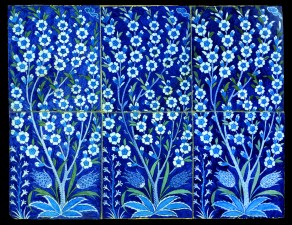The great Ottoman traveler Evliya Çelebi traversed the vast lands of the Ottoman Empire and places beyond, recording both the mundane and the fantastic, from the number of public baths in a given town to tales of magic, wonder, and the machinations of dark and mysterious powers. In the especially charming selection below, he describes the unique lifestyle of the residents of Diyarbakır, a city in what is now southeast Turkey. The description- of the marvelous gardens and temporary summer dwellings therein, and the entertainments associated with them- speaks for itself, so I won’t elaborate further. While the particularities of the situation are perhaps unique to Diyarbakır and its geographic and ecological situation, other themes can be traced elsewhere in the Empire: the importance of sociability, especially in semi-public spaces like gardens, accompanied by music and drink, can be traced all through this period and the following century, despite the protests of the more puritanical-minded among the ‘ulama. The seamless integration of Sufi musical practice with the more ‘secular’ preceding night’s entertainment is also worth noting.

But Diyarbekir’s basil gardens and regularly laid out vegetable plots on the bank of the Tigris have no equal in Rum or the Arab lands or Iran. When, in the spring season, the flood period of the Tigris has passed and its limpid waters begin to flow [again] in a stable current, all Diyarbekir’s inhabitants, rich and poor alike, move with their entire families to the bank of the Tigris. They settle down under tents and pavilions along this wide water, on the plots that they have inherited from their fathers and ancestors, and they sow and cultivate in their gardens melons, water melons, various vegetables and flowers. They cultivate here a special type of basil, which everyone plants along the borders of his plot. In a month’s time it becomes [dense] like a forest and as high as a spear’s length so that it is impossible to look through the basil and see what is inside. The doors and walls, the gates and roofs of all these make-shift habitations on the bank of the Tigris are entirely made out of basil…. These pavilions are so densely overgrown with basil that the nostrils of the men and women living in them are scented night and day with the fragrance of basil and the other flowers in these gardens, such as roses, Judas-trees, and hyacinth. The women’s quarters of each garden are also such open-air pavilions of basil. The ponds and fountains in each pavilion all receive their water from the river Tigris. Between all these gardens and vegetable plots run numerous canals and watercourses which people have diverted from the Tigris to their regularly laid-out vegetable gardens.
For a full seven months a merry tumult, with music and friendly talk, is so going on night and day here on the bank of the river Tigris, as in each pavilion people are passing their time with their beloved and close friends, in jollity and drinking, enjoying concert sessions [like those] of Huseyn Bayqara[‘s court]. All the artisans however remain busy with the crafts during this garden season; [so that] all sorts of food and drink are available. Thousands go to the city in the morning and pursue their respective jobs; and in the late afternoon they return in swarms to the gardens on the banks of the Tigris, to indulge in pleasure and enjoyment…
In short, the people of Diyarbekir arouse the envy of the whole world because of the pleasures and enjoyments that they have on the bank of the Tigris for seven or eight months [of the year], their nights being [like] the Night of Power, and their days [like] the Feast of Sacrifice. They hold banquets like Husayn Bayqara’s, thinking to snatch a bit of pleasure from this transitory world. Each night the banks of the Tigris are illuminated with oil lamps, lanterns, wind tapers and torches, and people arrange in thousands of artful ways oil lamps and wax candles on boards, [which they then put to float on the Tigris], so that the lights are drifting from one side to the other, and the darkest night becomes like a brilliant day. In each pavilion singers and musicians, clowns, minstrels and story-tellers perform, players of the lute, the çartar, the şeşetar, the berbut, the qanun, the çeng, the rebab, the musqar, the tanbur, the santur, the nefir, the balaban, the ney, and the dehenk, in short all sorts of musicians with string and wind instruments give performances like those at Bayqara’s court, continuing until the break of dawn, when the Muslim muezzins chant with their sorrowful voices the glories of God, as it to apologize, and all the followers of the [Sufi] path and faithful lovers [of God] begin their recitations in praise of Oneness, in the spirit of Pythagoras the Monotheist. For since the people of Diyarbekir all belong to the order of the Khwajagan and the Gülşeni order they do not miss the ecstatic joy and delight of ritual chantings. In conclusion [one may say that] while busy intercourse and buzzing conversation go on these Iram-like gardens, the people continually pray for the perpetuation of the imperial state (devlet). May God exalt their spiritual stations!
Evliya Çelebi, Seyahatname, translated by Martin Van Bruinessen and Hendrik Boeschoten, in Evliya Çelebi in Diyarbekir (Leiden: Brill, 1988), 177-181
